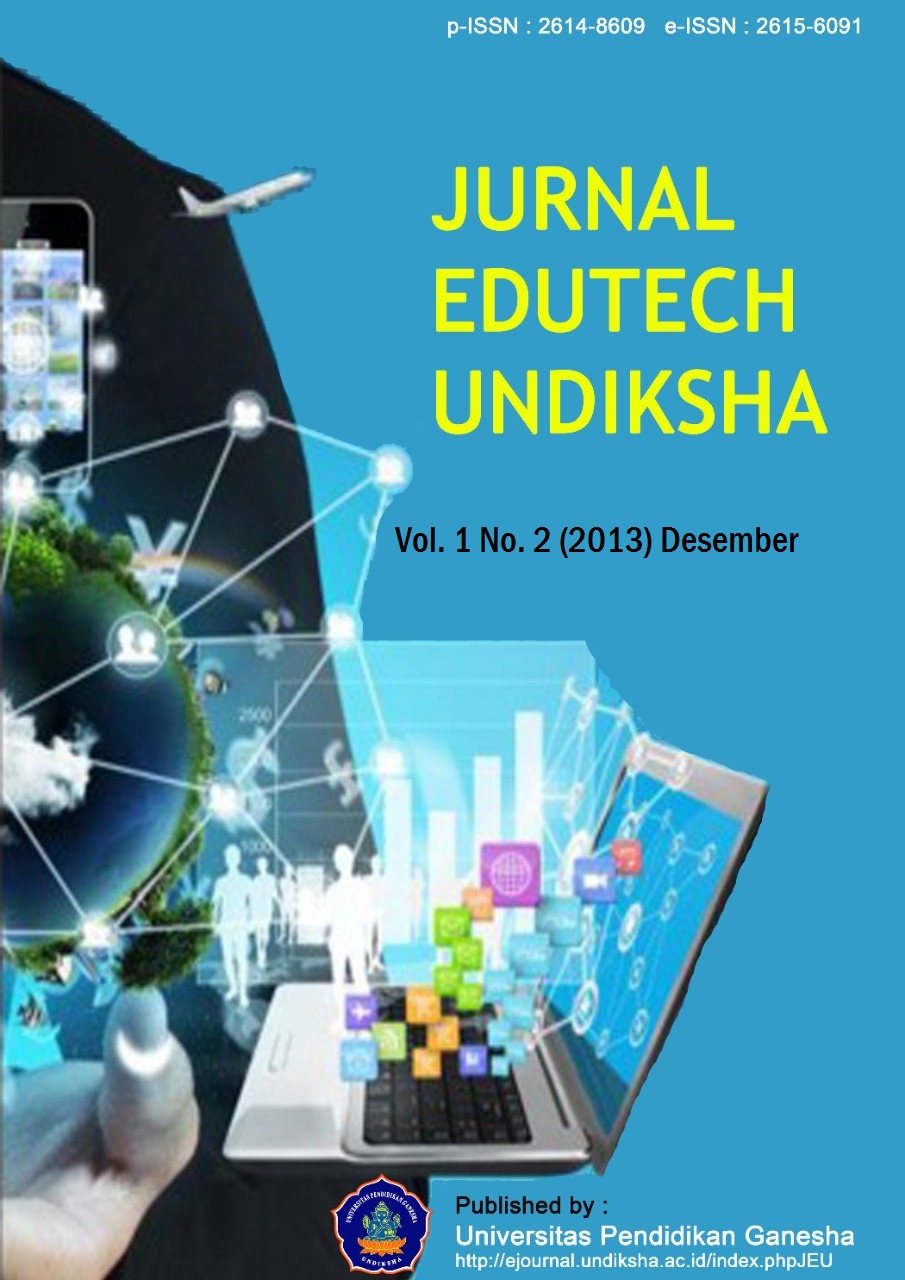PENGARUH STRATEGI PEMBELAJARAN MIND MAPPING BERBANTUAN MEDIA POWER POINT TERHADAP HASIL BELAJAR SOSIOLOGI SISWA KELAS X DI SMA NEGERI 1 TEJAKULA TAHUN 2013/2014
DOI:
https://doi.org/10.23887/jeu.v2i1.3948Abstract
Permasalah dalam penelitian ini adalah proses pembelajaran yang diterapkan lebih ditekankan pada metode pembelajaran yang masih bersifat konvensional serta kurang kurangnya pemafaatan media dan nilai siswa dibawah KKM. Tujuan dari penelitian ini adalah mengetahui perbedaan hasil belajar Sosiologi antara kelompok siswa yang diajar dengan strategi pembelajaran mind mapping berbantuan media PowerPoint dengan siswa yang mengikuti pembelajaran menggunakan strategi pembelajaran konvensional pada siswa kelas X semester ganjil SMA Negeri 1 Tejakula tahun pelajaran 2013/2014. Penelitian ini adalah eksperimen semu (quasi eksperiment) dengan rancangan “post test only control group design”. Populasi dalam penelilitian ini adalah siswa kelas X semester genap SMA Negeri 1 Tejakula. Dari lima kelas yang ada, kelas X1 sebanyak 31 orang siswa sebagai kelas eksperimen dan X2 sebanyak 30 orang siswa sebagai kelas kontrol dengan teknik random kelas. Data penelitian ini diambil dengan menggunakan metode tes dan instrumen yang digunakan sebagai penilaian berupa tes obyektif pilihan ganda (Multiple Choice Item Test) dengan satu jawaban benar. Hasil tes selanjutnya dianalisis dengan menggunakan teknik statistik uji-t. Berdasarkan hasil uji hipotesis yang telah dilakukan dengan uji-t ditemukan bahwa terdapat perbedaan hasil belajar Sosiologi yang signifikan antara siswa yang mengikuti pembelajaran menggunakan strategi pembelajaran Mind Mapping berbantuan media PowerPoint dengan siswa yang mengikuti pembelajaran menggunakan model pembelajaran konvensional pada siswa kelas X di SMA Negeri 1 Tejakula tahun pelajaran 2013/2014, (t hitung = 2,840 > t tabel = 2,000). Hal ini terbukti dari tingginya hasil belajar siswa kelas X1 SMA Negeri 1 Tejakula tahun pelajaran 2013/2014 selaku kelompok eksperimen setelah mengikuti pembelajaran menggunakan strategi pembelajaran problem Mind Mapping berbantuan media pembelajaran berbasis Ms.PowerPoint, dibandingkan dengan siswa kelas X2 di SMA Negeri 1 Tejakula tahun pelajaran 2013/2014 selaku kelompok kontrol yang mengikuti pembelajaran menggunakan strategi pembelajaran konvensional ( 1=19,935> 2=17,067). Berdasarkan hal tersebut dapat disimpulkan bahwa strategi pembelajaran mind mapping berbantuan media PowerPoint berpengaruh terhadap hasil belajar Sosiologi pada siswa kelas X di SMA Negeri 1 Tejakula tahun pelajaran 2013/2014Kata Kunci : Mind Mapping , media power point, hasil belajar Sosiologi.
Problems in this research is a learning process that is applied to more emphasis on teaching methods that still conventional and less lack pemafaatan media and student scores below the KKM. The purpose of this study was to determine differences in learning outcomes between groups Sociology students who are taught with strategies of media-assisted learning mind mapping PowerPoint with students who take learning using conventional learning strategies in class X SMA semester 1 2013/2014 school year Tejakula. This study was a quasi-experimental (quasi experiment) with the draft "post-test only control group design". The population in this penelilitian is class X SMA semester 1 Tejakula. Of the five classes, the class X1 as many as 31 students of the experimental class and X2 as many as 30 students as a control class with a class of random techniques. The research data was taken using the test methods and instruments used for assessment in the form of multiple choice objective test (Multiple Choice Test Items) with the correct answer. The test results were then analyzed using t-test statistical technique. Based on the results of hypothesis testing that has been done by t-test found that there are differences in learning outcomes Sociology significantly between students who take learning to use learning strategies Mind Mapping PowerPoint-assisted media with students who take learning using conventional learning models in class X in SMA 1 Tejakula 2013/2014 school year, (t = 2.840> t table = 2.000). his is evident from the high grade of student learning outcomes X1 SMA Negeri 1 Tejakula 2013/2014 school year as the experimental group after participating in learning using learning strategies Mind Mapping assisted problem-based learning media Ms.PowerPoint, compared with X2 grader at SMA 1 year Tejakula 2013/2014 subjects as a control group that followed the conventional learning using learning strategies (1 = 19,935> 2 = 17,067). Based on this it can be concluded that the strategy of media-assisted learning mind mapping PowerPoint Sociology effect on learning outcomes in class X in SMA 1 Tejakula school year 2013/2014.
keyword : Mind Mapping, media power point, the results of study of Sociology.
Published
2014-08-07
How to Cite
., M. A. W., ., D. K. P., & ., I. K. S. S. (2014). PENGARUH STRATEGI PEMBELAJARAN MIND MAPPING BERBANTUAN MEDIA POWER POINT TERHADAP HASIL BELAJAR SOSIOLOGI SISWA KELAS X DI SMA NEGERI 1 TEJAKULA TAHUN 2013/2014 . Jurnal Edutech Undiksha, 2(1). https://doi.org/10.23887/jeu.v2i1.3948
Issue
Section
Articles
License
Authors who publish with the Jurnal EDUTECH Undiksha agree to the following terms:
- Authors retain copyright and grant the journal the right of first publication with the work simultaneously licensed under a Creative Commons Attribution License (CC BY-SA 4.0) that allows others to share the work with an acknowledgment of the work's authorship and initial publication in this journal.
- Authors are able to enter into separate, additional contractual arrangements for the non-exclusive distribution of the journal's published version of the work (e.g., post it to an institutional repository or publish it in a book), with an acknowledgment of its initial publication in this journal.
- Authors are permitted and encouraged to post their work online (e.g., in institutional repositories or on their website) prior to and during the submission process, as it can lead to productive exchanges, as well as earlier and greater citation of published work. (See The Effect of Open Access)














